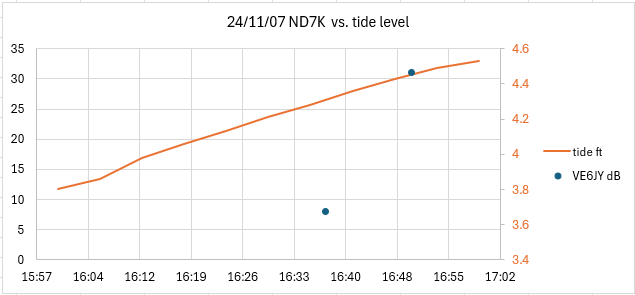In radio engineering as in all thing, it pays to be kind. This morning while activating US-0757 with TouCans Vertical, I noticed a swimmer I'd seen before headed towards the pier I was prerched on.
Bear with me a little nautical explanation is in order to understand the rest of the this tale, so here goes.
There are currents in the San Francisco Bay. Currents thtat sweep out towards the ocean are called ebb currents. Currents that see in from the ocean are called flood currents. Even at Hyde St. PIer in its somewhat sheltered indentation in the shore of the Bay, swimmers experience these currents. They're a thing and sometimes they're just about as fast as a swimmer cares to swim.
Getting back to this morning, the swimmer I saw coming occaionally takes advantage of currents to do 'infinite lap pool' swimming under the pier. She backstrokes while going nowhere because she adjusts her speed to the speed of the current. She also sings quite pleasantly while doing all this.
Anyway, I saw her headed towards the pier I was seated on and immediately pulled up the ground wire for Project TouCans that had been suspended in the Bay water below till just then. And. AND! And?
The receive signal got so much better! The interfering AM broadcast station went away all toghether. Some of the noise from the power supply went away. But wait! There's more! The transmit signal, (as exhibited by the Reverse Beacon Network stayed the same! It even got a bit stronger over time as the POTA carried on!
I don't know what the mechanism is that caused this, but I'm loving it! I activate the park in just under an hour. It turns out the vertical antenna only takes about 10 minutes to set up at a location I'm already familiar with.
Here's the QSO map for the activation
| Callsign | tx RST | rx RST | Time (GMT) | Frequency |
|---|---|---|---|---|
| kg6oki | 449 | 559 | 2024/11/04 15:15:00 | 14057.4 |
| ve7vak | 339 | 559 | 2024/11/04 15:19:00 | 14057.4 |
| ad0wb | 559 | 559 | 2024/11/04 15:23:00 | 14057.4 |
| n6gc | 569 | 599 | 2024/11/04 15:30:00 | 14057.4 |
| kq6qb | 49 | 559 | 2024/11/04 15:34:00 | 14057.4 |
| k7evm | 339 | 559 | 2024/11/04 15:36:00 | 14057.4 |
| k6hwd | 339 | 599 | 2024/11/04 15:39:00 | 14057.4 |
| k7tmm | 559 | 599 | 2024/11/04 15:41:00 | 14057.4 |
| k7sps | 339 | 599 | 2024/11/04 15:45:00 | 14057.4 |
| w6zkh | 339 | 559 | 2024/11/04 15:48:00 | 14057.4 |
| kc7wxd | 339 | 599 | 2024/11/04 15:50:00 | 14057.4 |
| n6ilj | 339 | 529 | 2024/11/04 15:54:00 | 14057.4 |
Here's the data for Reverse Beacon Spotting station SNR with respect to tide levels in the Bay







Comments
Post a Comment
Please leave your comments on this topic: